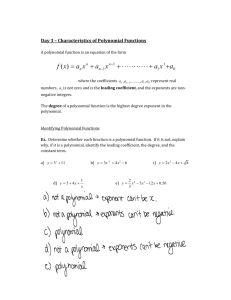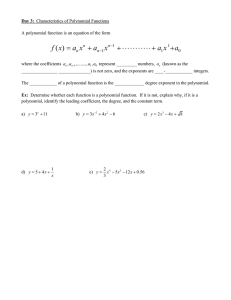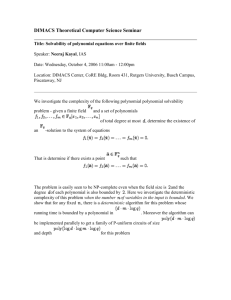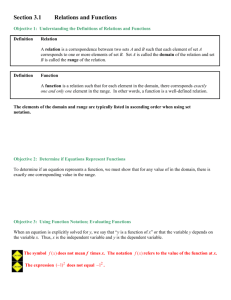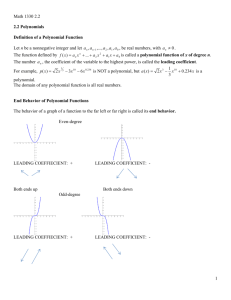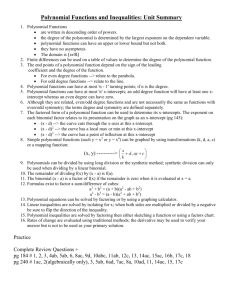Day 3 Notes – Characteristics of Polynomial Functions
advertisement
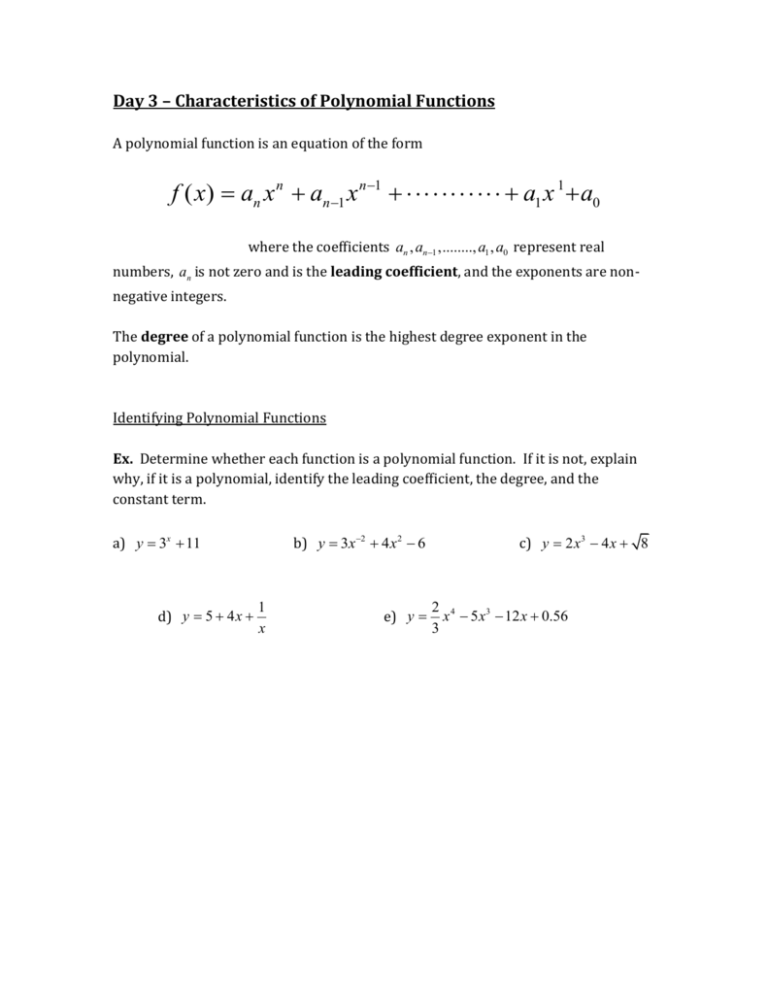
Day 3 – Characteristics of Polynomial Functions A polynomial function is an equation of the form f ( x) an x n an 1 x n 1 a1 x 1 a0 where the coefficients an , an1 ,........, a1 , a0 represent real numbers, an is not zero and is the leading coefficient, and the exponents are nonnegative integers. The degree of a polynomial function is the highest degree exponent in the polynomial. Identifying Polynomial Functions Ex. Determine whether each function is a polynomial function. If it is not, explain why, if it is a polynomial, identify the leading coefficient, the degree, and the constant term. b) y 3x 2 4 x 2 6 a) y 3x 11 d) y 5 4 x 1 x e) y c) y 2 x 3 4 x 8 2 4 x 5 x3 12 x 0.56 3 Characteristics: Degree 0 – Constant Degree 1 – Linear Degree 2 – Quadratic Degree 3 – Cubic Degree 4 – Quartic Degree 5 - Quintic Odd Function End behaviour 𝑎𝑛 > 0 End behaviour 𝑎𝑛 < 0 x–intercepts y- intercepts Domain Range Even Function Every polynomial function that includes a variable has a value, or values, of the variable for which the corresponding value of the function is zero. These values of the variable are the zeroes of the function and are the solutions to the corresponding equation f ( x) 0 or y 0 . The real zeroes of a function are the x-intercepts of its graph. Some graphs of polynomial functions have symmetry. The function y x3 is symmetric about the origin (a 180° rotation maps y x3 onto itself). The function y x 2 1 is symmetric about the y-axis. Match a Polynomial Function with its Graph Ex. For each of the following functions, identify the following: the type of function and whether it is of even or odd degree, the end behaviour of the graph of the function, the number of possible x-intercepts, whether the graph will have a maximum or minimum value, the y-intercept. Then match each function to its corresponding graph. 𝒂) 𝒈(𝒙) = 𝒙𝟒 + 𝟒𝒙𝟑 − 𝒙𝟐 − 𝟏𝟔𝒙 − 𝟏𝟐 b) 𝒇(𝒙) = −𝒙𝟒 + 𝟗𝒙𝟐 + 𝟓𝒙 − 𝟒 c) 𝒌(𝒙) = −𝟐𝒙𝟓 + 𝟓𝒙𝟑 − 𝟐𝒙 d) 𝒉(𝒙) = 𝟑𝒙𝟑 − 𝒙𝟐 − 𝟒𝒙 − 𝟐 Answers: a b c Type Odd or Even End Behaviour Maximum number of x-intercepts Maximum or minimum y -intercept Graphs: A) B) 16 16 y y 14 14 12 12 10 10 8 6 8 4 6 2 4 x 0 -8 -6 -4 2 x -6 -4 -2 0 2 4 6 8 -2 -4 0 -8 -2 0 2 4 6 8 -6 -2 -8 -4 -10 -6 -12 -14 -8 -16 -10 -18 -12 -20 -14 -22 -24 -16 C) D) y y 28 26 4 24 22 20 18 2 16 14 12 10 8 x 0 -4 6 -2 0 4 2 x 0 -8 -6 -4 -2 0 -2 2 4 6 8 -2 -4 -6 -8 -10 -4 -12 -14 2 4 d
